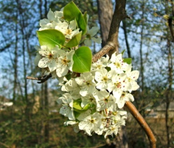Callery Pear
(Pyrus calleryana Dcne.)
Family: Rose family (Rosaceae)
Native Range: China, Vietnam
 Callery pear is an upright, pyramidal tree that grows 20–30 ft. tall, with a 20–30 ft. wide canopy. Young trees are relatively slender and may be thorny. Its alternate leaves are oval, up to 3 inches long and 1 1/2 to 3 inches wide, with small, round-toothed margins; long petioles make the leaves flutter in the wind. The leathery leaves are a glossy dark green during the summer, turning scarlet or reddish-purple in fall. Flowers of the Callery pear are creamy white and showy (3/4 inch wide), with 5 petals and numerous yellow stamens in the center. Dense clusters (corymbs) of the malodorous flowers appear in spring before the trees leaf out. Well-known cultivars of the Callery pear include the Bradford pear, Chanticleer, Aristocrat, and Cleveland select.
Callery pear is an upright, pyramidal tree that grows 20–30 ft. tall, with a 20–30 ft. wide canopy. Young trees are relatively slender and may be thorny. Its alternate leaves are oval, up to 3 inches long and 1 1/2 to 3 inches wide, with small, round-toothed margins; long petioles make the leaves flutter in the wind. The leathery leaves are a glossy dark green during the summer, turning scarlet or reddish-purple in fall. Flowers of the Callery pear are creamy white and showy (3/4 inch wide), with 5 petals and numerous yellow stamens in the center. Dense clusters (corymbs) of the malodorous flowers appear in spring before the trees leaf out. Well-known cultivars of the Callery pear include the Bradford pear, Chanticleer, Aristocrat, and Cleveland select.
Reproductive/Dispersal Methods
The hard, greenish-brown fruits, which mature in fall, are up to 1 inch in diameter. Although inedible to humans, the fruits are eaten by birds such as starlings, which spread them over wide areas; the fruits may also be eaten by small mammals. The seeds germinate and grow rapidly in disturbed areas. The tree can also spread by vegetatively by suckers.
Similar Species
Common pear (Pyrus communis) has much larger fruits, which of course are edible and delicious.
Impacts
Callery pear has been widely planted as an ornamental tree in yards, parks, and along streets. In the wild, Callery pears can rapidly form dense, thorny thickets. The trees crowd out native species that are unable to compete with them for light, soil, and water.
Distribution
Callery pear is native to China and Vietnam. It was introduced into the United States as an ornamental, and has now naturalized in much of the eastern half of the United States, ranging from New Hampshire to Florida on the east coast, and west to Illinois, Kansas, and Texas.
Sources and Links:
IPANE Database
https://www.invasiveplantatlas.org/subject.cfm?sub=10957
USDA Plants Database
http://plants.usda.gov/core/profile?symbol=PYCA80
Missouri Botanical Garden
http://www.missouribotanicalgarden.org/PlantFinder/PlantFinderDetails.aspx?kempercode=a720